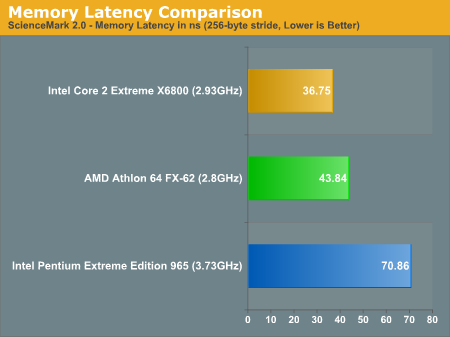Intel's Core 2 Extreme & Core 2 Duo: The Empire Strikes Back
by Anand Lal Shimpi on July 14, 2006 12:00 AM EST- Posted in
- CPUs
Memory Latency: No Integrated Memory Controller Necessary
One thing we pointed out in our earlier preview coverage of Intel's Core 2 Extreme is that the new processors have extremely low latency memory access, despite relying on the same memory controller as the previous generation of Intel CPUs.
Without an on-die memory controller Intel's Core 2 processor must use the memory controller in its chipset, which currently means the 128-bit DDR2 memory controller in either Intel's 965 or 975X chipset. The confusing thing is that although the Core 2 processors use the same memory controller as the old NetBurst processors, memory latency has been improved tremendously:

Intel's Core 2 processors now offer even quicker memory access than AMD's Athlon 64 X2, without resorting to an on-die memory controller. While Intel will eventually add one, the fact of the matter is that it's simply not necessary for competitive memory performance today thanks to Intel's revamped architecture. Update:As many astute readers have pointed out, Core 2's prefetchers are able to work their magic with ScienceMark 2.0, which results in the significant memory latency advantage over AMD's Athlon 64 FX-62. This advantage will not always exist; where it doesn't, AMD will continue to have lower latency memory access and where it does, Intel can gain performance advantages similar to what ScienceMark 2.0 shows.
| CPU | Everest |
CPU-Z 1.35 (8192KB, 128-byte stride) | CPU-Z 1.35 (8192KB, 64-byte stride) |
| AMD Athlon 64 FX-62 (2.8GHz) | 45.9 ns | 43.2 ns | 19.3 ns |
| Intel Core 2 Extreme X6800 (2.93GHz) | 59.8 ns | 52.8 ns | 10.9 ns |
Because of the Core 2's intelligent prefetchers doing too good of a job with ScienceMark memory latency test, we wanted to also showcase situations where Core 2 would feature slower memory accesses than the AMD platform with its integrated memory controller. Everest's results are more in line with what we'd expect to see, with the FX-62 offering over 23% faster memory accesses than the X6800. CPU-Z's latency tool also reported somewhat similar findings, with an 18% performance advantage due to AMD's integrated memory controller. CPU-Z also provided us with numbers that showcase how well Core 2 can perform if its prefetchers are able to "guess" correctly; at lower strides the Core 2 Extreme manages faster memory access than the FX-62. The 128-byte stride numbers are indicative of what will happen if the pre-fetchers are not able to get the Core 2 the data it needs, when it needs it, while the 64-byte numbers show you what can happen when things go well.










202 Comments
View All Comments
bob661 - Friday, July 14, 2006 - link
I agree. 20% is huge and noticeable.Chadder007 - Friday, July 14, 2006 - link
AMD's midrange holds up pretty well but when you go higher the Core2 crushes AMD this time.I would really like to see some X64bit benchmarks though to see how they will both fair with the future OSs.
Gary Key - Friday, July 14, 2006 - link
Coming shortly along with MCE2005......bob661 - Friday, July 14, 2006 - link
Don't confuse the Core Solo with the Core 2 Duo. The Solo is still Netburst whereas the Core 2 Duo is a new architecture.DrMrLordX - Friday, July 14, 2006 - link
Um what? Core Solo isn't Netburst. It's a single-core version of Yonah as I recall. Basically, it's similar to a Dothan.bob661 - Friday, July 14, 2006 - link
Which is still Netburst.mlittl3 - Friday, July 14, 2006 - link
Uh, no. Banias, Dothan, Yonah are not at all based on netburst. They are all P6 derivatives that use the netburst quad-pumped FSB. The Core Solo is a Yonah single core that has more in common with the PIII than the P4. The Core 2 Solo coming next year will be based on Conroe which of course is not Netburst. The ONLY, I repeat, ONLY netburst CPUs (not including Xeons) are the Pentium 4, Pentium D, Celeron D. There were mobile Pentium 4's on the netburst architecture but these haven't been used in years.The Pentium M (Banias and Dothan) is NOT based on netburst but a redesigned architecture based on the research in Israel.
mlittl3 - Friday, July 14, 2006 - link
And in case you try to stupidly refute me, list the number of pipelines that are in Banias, Dothan and Yonah. If the answer is less than 20, then it is NOT netburst.Oh wait, here is the answer right here.
http://en.wikipedia.org/wiki/Intel_P6">http://en.wikipedia.org/wiki/Intel_P6
A direct quote:
"It[Banias] has very limited system bandwidth, as compared to NetBurst and AMD64..."
Since Banias is not netburst and Dothan is based off of Banias and Yonah is based on Dothan, then...wait for it...all three are not netburst. Have a nice day! :)
bob661 - Friday, July 14, 2006 - link
I don't refute facts. :)mlittl3 - Friday, July 14, 2006 - link
Man after my own heart. :)